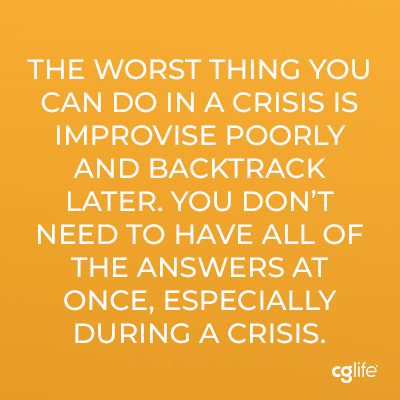

Crisis Communications: Advice for Sharing Information in Critical Situations
A crisis communication plan is one of those things that you hope you never need. Yet, many companies realize they need a plan when they are smack dab in the middle of a crisis. If you are one of those companies, all is not lost! With a level head and some helpful tips to drive a strategic approach, you can still master the art of communicating with your customers, prospects, and the media during an unforeseen catastrophe, even a global pandemic.
To provide context, a crisis communications plan is a set of guidelines used to prepare your business for an emergency or unexpected event. An unscheduled coronavirus quarantine clearly fits that definition. Consider it a playbook to help you thoughtfully, professionally, and respectfully respond to a crisis. The steps you take in an urgent situation will ensure important information reaches all of your most valued stakeholders, while allowing you to protect the reputation of your brand.
Here’s how you can master the moment:
Identify a Plan of Action
One of the fastest ways to calm anxiety or manage a fervor of publicity is to clearly outline the actions your organization will take to manage or correct the situation. If it’s an unexpected quarantine, communicate the steps your company is taking to serve your customers. Whether it be business as usual or a temporary impact on response times, it’s best to be upfront and transparent. By being the primary source of information, you are better able to manage the emotion and concern associated with the issue. Use all your communication channels to inform customers, clients, and employees. This includes email messages, social media posts, website notifications, as well as internal tools like message boards or collaboration tools. Proactively provide responses to questions. It is not enough just to send out the message, assign appropriate team members to respond to questions and comments. Proactively answering positions your organization as caring, engaged, and responsive team.
Clarify your Message


Regardless of the type of crisis, be it an unexpected closure of your business due to the coronavirus, an awkwardly received ad campaign, a workplace incident, or a politically charged issue, consistency in the message you deliver is crucial. Outline your message points, ensure they align with your core values, practice your responses, and troubleshoot questions. Lean on your team (even the more distantly related members) to conduct a dry run. Their feedback and questions may offer additional perspectives you hadn’t considered, and if nothing else, will serve as great practice. All of this preparation will keep you on message and able to quickly think on your feet. If there is something you aren’t prepared to comment on that do you get asked, it is OK to respond by letting your stakeholders and interviewers know that you will get back to them. The worst thing you can do in a crisis is improvise poorly and backtrack later. You don’t need to have all of the answers at once, especially during a crisis.
Identify your Mouthpiece
Company messages are more influential and reliable if they come from a trusted, experienced voice. Consider your audience and identify the most appropriate spokesperson but remember that the spokesperson may change depending on the audience. For example, your company CEO or CFO might be best to address investors. Your customer care executive might be preferred while emailing loyal customers. Your PR person may be best suited for communicating directly to the media. Whoever is tapped to speak on behalf of the organization should be trained and well-versed to represent your brand message, culture, tone, and mission. All spokespeople should work and practice together to ensure their audience-centric messages are aligned with approved responses. Teamwork makes the dream work…as they say!
Proactively Communicate
This is where your lifelong dreams of being a super sleuth are realized! Being proactive means being aware of brewing situations. Actively monitoring news and stakeholder communications channels allows you to identify trends that could turn into unforeseen concerns. As an issue begins bubbling up, rally your team to help get a good understanding of the matter. If it’s a global pandemic, make this the topic of your executive leadership meetings. As a team, you can collectively evaluate the news to ensure that you are planning ahead for the crisis as it changes. If it’s a negative reaction to a campaign, gather your marketing and customer facing teams to actively monitor responses coming into your customer service lines, comments on social media, and questions from the press. If you are responding to a workplace crisis, information will need to be gathered at rapid speed. Work with human resources and department leaders to quickly assess the situation and provide an outward response. Your communications may need to be adapted as information becomes available, but that’s ok…. by getting ahead of the situation you have an opportunity to manage the outcome proactively. Sometimes you may just be behind the scenes gathering information and monitoring the situation just in case the situation does boil over. That said, if you feel a response is warranted, do it quickly so the external chatter does not get out of control.
Keep Everyone on the Same Page


In an emergency, it’s likely the situation is evolving quickly with new information coming to light rapidly. To keep messages concise and consistent, meet with your identified crisis team hourly or daily, depending on the emergency’s fluidity. Your team should include representatives from leadership and key departments. Use this time to clear up misunderstanding, align on updated information, and connect your leadership, so they can accurately communicate to staff and stakeholders. A crisis is not the time for a game of email tag. It warrants face-to-face conversations, working groups, and brainstorms, even if it requires you all to stay 6 feet apart or meet over video chat.
Think of All Touchpoints
Each company has a multitude of audiences on varying platforms, like your website, weekly stakeholder emails, social media sites, and even on-hold messages. No matter the distribution channel for communications, be sure the message is specifically tailored to the needs of that audience. Social media, for example, may require a mix of short digestible and shareable messages, while journalists will want just the facts in a press release or press conference. Don’t forget to include the people on your team that are needed to ensure a smooth execution. With messages going out across a multitude of platforms, this may be your IT team’s big shining moment as they maintain connectivity and ensure all messages are sent!
Do the Things
Once you’ve identified and communicated the steps needed to address the problem, it’s imperative that you follow through faithfully. Remember to offer solutions to problems within your capabilities, like making a financial donation to support healthcare workers or promising customers that you will respond to inquiries within two hours. No matter what remedies you have chosen, you must honor the commitments and promises made. Be prepared to share the amount donated. If you made a time specific pledge, you better set a timer to ensure you keep that commitment. Given how fast things can change, it may be hard to predict your future ability to complete the tasks you’ve committed to. While your customers may be understanding, if they detect a pattern of unreliability it may hurt you later. The actions you take during a crisis will significantly impact your company’s future credibility, so make sure to avoid overpromising and stick to your pledges.
No one could have ever predicted the far-reaching impact of COVID-19. These unprecedented times have left everyone scrambling to communicate with audiences, while needing to determine new processes that will allow businesses to help and serve everyone. It’s a lot, we know! However, with a calm, thoughtful approach, you can preserve the reputation of your company, while gaining trust. Plus, the time you invest on a more extensive plan may keep your business ahead of the next crisis. That said, here’s hoping things return to normal soon and that the next crisis is in the very distant future!


Looking for more advice to help weather a storm? Read some considerations for media outreach during uncertain times and/or our tips for internal communications while working from home.
